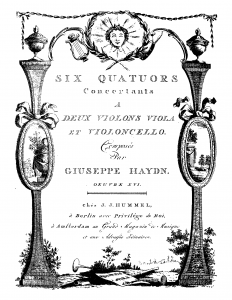
Béla Bartók
Credit: http://i.telegraph.co.uk/
Joseph Haydn is called the “Father of the String Quartet,” although he certainly wasn’t the man who invented the form. He was, however, one of the greatest early composers for the String Quartet and wrote 83 of them. One of his most innovative collections was the “Sun” Quartets, not named for their sunny disposition but for the prominent sun smiling from the front cover.
The six Sun Quartets themselves are little gems that show so many of the varieties of music in the early quartet: first movements in sonata allegro form, minuets as either second or third movements, and final movements that, in three cases, are built around fugues (on 2, 3 or 4 subjects). Ethnic music shows up in the fourth quartet where the minuet is “alla zingarese” (in a gypsy style) with sharp accents and jagged rhythms.
Haydn: String Quartet No. 27 in D Major, Op. 20, No. 4, Hob.III:34, III: Menuetto: Allegretto alla zingarese (Pellegrini Quartet)
From the violin-centered beginning, we start to change timbre and then the lower voices come to the fore, particularly in the trio. Each of the four members of the quartet comes forth and speaks.
By the time we get to Beethoven, the quartet has become darker and more introspective. The school friends we met in Haydn have gone to university and gotten into philosophy and existentialism.
Beethoven: String Quartet No. 13 in B-Flat Major, Op. 130: I. Adagio ma non troppo – Allegro (Alban Berg Quartet)

Sun Quartet cover
Beethoven was taking on a genre that would have seemed to have been perfected in the hands of Haydn and Mozart but his contributions made it possible for the quartet to become a living art form. When we look at what the quartet became in the 20th century, in the hands of masters such Bartók, we see how far the quartet has come.
Bartók wrote only 6 quartets and they serve as milestones in the history of the quartet. Just as with Haydn and Beethoven’s quartets, Bartók’s provide an overview of the composer’s work at each point in his career. We see his interest in Hungarian folk music emerge in his Third Quartet (1927), but it’s integrated with an intense contrapuntal line equal to anything Beethoven constructed. By the time of his Sixth Quartet (1939), the individual voices are isolated, beginning with the opening played by the solo viola. All four instruments come together and then they seem to wander away, each on their own path. Yet, in the end, the result is like listening not to the discussion of the 4 rational people that Goethe knew, but a brain-storming session conducted by 4 brilliant experts, each putting forth their reasons and listening to the other’s arguments.
Bartók: String Quartet No. 6, BB 119: I. Mesto – Piu mosso, pesante – Vivace (Vermeer Quartet)
Although an old-fashioned genre, the string quartet remains one of the most satisfying.
